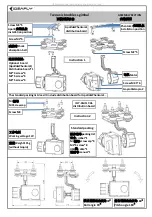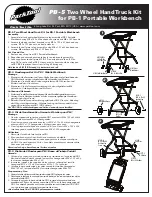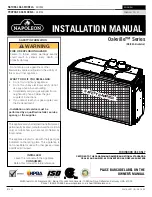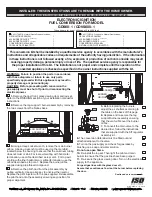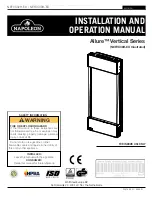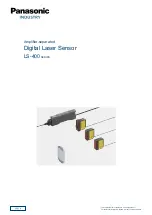
RXW Multi-Depth Soil Moisture Sensor (RXW-GPx-xxx) Manual
1-800-LOGGERS
7
www.onsetcomp.com
4.
At the location where you want to install the probe, use a
repetitive up-then-down motion on the slide hammer to
vertically drive the pilot rod into the soil. Be sure to hold
the slide hammer vertically without side-to-side movement.
Drive the pilot rod in until it reaches the tape marking made
in step 2.
5.
Once the pilot rod reaches the desired depth, extract the
pilot rod by using the slide hammer in reverse, lifting it
rapidly to hammer upwards. Be sure to hold the slide
hammer vertically without side-to-side movement to
extract the pilot rod straight up.
6.
Once the pilot rod is extracted, clear away any loose soil at
the top edges of the hole so that it doesn’t fall into the
hole.
7.
Insert the sensor probe into the hole, pressing it in as far as
possible by hand. Pour a bit of water around the probe at
the top of the hole if the soil is very tightly packed to help it
slide more smoothly into the hole. You can use a dead blow
hammer to gently tap the top of the sensor if you are
having trouble pushing in the sensor by hand.
Important:
Never use a regular hammer or other tool to
push in the sensor because other tools can damage the
internal electronics.
8.
Once the probe is fully inserted in the hole, pack the soil
around the top of the sensor to prevent water from
entering the hole. The sensor should be completely covered
with soil and only the sensor cable visible.
See
Checking Sensor Readings with HOBOlink
for details on
verifying that you have consistent sensor readings.
Auger Installation Method
1.
Drill a vertical hole with a 3 inch auger.
2.
Insert the sensor into the hole, making sure the entire
sensor body is in the hole.
3.
Make a slurry of the soil from the hole and pour it down
slowly so that it settles evenly around the sensor. Stop
pouring every few inches and give it time for the water to
drain from the soil and the soil to settle. Allow more time
for soils that retain water, such as clay soils.
4.
Make sure the sensor is completely covered with soil and
only the sensor cable visible.
See
Checking Sensor Readings with HOBOlink
for details on
verifying that you have consistent sensor readings.
Excavation Installation Method
1.
Dig a hole deep enough for the sensor probe and save the
soil on a plastic tarp or sheet. Lay out the soil on the tarp in
a row for the different depths so that you will be able to
easily return all the soil to the excavated hole in the correct
order.
2.
Place the sensor probe vertically in the hole.
3.
While supporting the sensor at the top and bottom so that
it does not move, backfill the hole with the soil that was
removed from the hole, restoring the original soil at each
depth as laid out on the tarp. To ensure the same soil
density as before the probe was installed, return the soil to
the hole in 8 to 10 cm (3 to 4 inch) layers. Tamp down each
layer with a 2.54 cm (1 inch) diameter metal rod, making
sure the soil is packed around and into the sensor so that
there is good soil contact on all sensor surfaces. The
accuracy depends on not having any air gaps around the
sensor. Be sure to keep the sensor vertical while backfilling
the hole.
4.
Once all soil has been returned to the hole, make sure the
excavation surface is level with the surrounding soil. The
sensor should be completely covered with soil and only the
sensor cable visible.
5.
Water the soil thoroughly after installation to help ensure
that the soil has filled in around the sensor.
See the next section for details on verifying that you have
consistent sensor readings.














